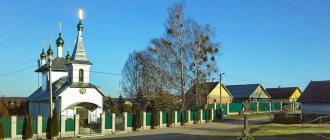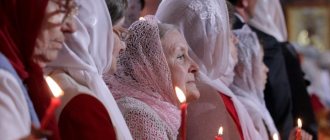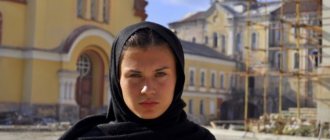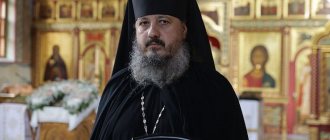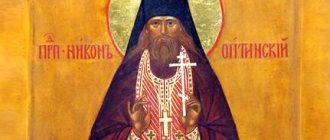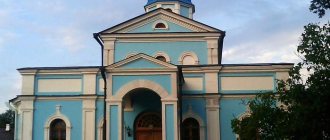On the day of remembrance of Metropolitan Philaret of Kyiv and Galicia
On the day of the blessed death
of His Eminence Philaret in schema-monasticism of Theodosius (Amphiteatrov), Metropolitan of Kiev and Galicia - † December 21/January 3, 1857.
The Russian Church knows many saints who were selflessly devoted to the work of their ministry. No matter what era they lived in, no matter what position in the Church they occupied, they zealously served God, filled with great love for people. Inspired by this love and living, sincere faith, they knew how to touch even the coldest hearts. One of these preachers in the 17th century was Demetrius of Rostov, who, living in an unusually difficult and harsh time, exuded love and affection for the suffering people. The greatest apostle of love was Tikhon of Zadonsk, whom even Leo Tolstoy, with all his negative attitude towards the Church, called the warmest of all Russian spiritual preachers.
Metropolitan Philaret of Kiev (Amphitheaters) was in his spiritual appearance the successor of St. Demetrius of Rostov and Tikhon of Zadonsk. Love, kindness, mercy, a compassionate heart - these are the main features of him as a person, as an archpastor, as a preacher.
His life and pastoral activity are the living embodiment of an active, active service of love. Within the walls of the theological schools, which he successfully nurtured, in the monasteries of which he was the abbot, in the administration of dioceses, the geography of which is so vast, - in the preaching pulpit, among the clergy and laity - everywhere the archpastor gave his co-secretaries, associates and flocks a worthy example of inexhaustible love for people. That is why even now, 163 years after the day of his blessed death, he, in the face of the merciful saint, invariably remains with us.
Remembering Metropolitan Philaret today, I would like to dwell on that stage of his varied and stormy activity, which is associated with the Kaluga diocese, where His Beatitude worked for Christ in the period from 1819 to 1825. After all, it was during this period, in 1820, that he conceived the creation of a monastery at the Optina Monastery, and in 1821 he put this plan into action. Thus, the coming year 2022 will be marked by a historical date for the Optina monastery - the bicentenary of the founding of the St. John the Baptist Skete at Optina Hermitage by Metropolitan Philaret (Amphitheater). Let's not forget how it all began...
The first monasteries
The first hermitage settlements arose at the same time as the emergence of Christianity as a new religion; they were the first settlements of monks. The first Christian ascetics often chose remote, deserted areas to live in, so that worldly affairs and concerns would not become an obstacle to selfless service to God.
Skete of St. Anne on Mount Athos
The first Christians were often persecuted, so services had to be held in secret churches, and the monks and clergy themselves lived in remote places. The spread of the hermitage movement is closely related to the emergence of hermitage.
Important! The concept of “skete” comes from the name of the Skete hermitage.
It was the first monasteries that became the prototype of modern monasteries. They formed a way of monastic life, which later became the basis of the way of life of any monastery. Now monasteries and monasteries have some differences. For example, monks living in a hermitage take additional vows. These include a vow of seclusion, strict fasting, and an enhanced prayer rule.
Links[edit]
- "The Coptic Monasteries of Wadi Natrum", Bulletin of the Metropolitan Museum of Art, Vol. 6, No. 2, (February 1911) 19–20.
- El-Meskin, Matta, Coptic Monasticism and the Monastery of St. Macarius: A Brief History, printed at the Monastery of St. Macarius, Cairo, 2001.
- Russell, Norman, Lives of the Desert Fathers, Cistercian Publications: Kalamazoo, 1981 (this work is a collection of sayings collected in the 6th century).
- Russell, Dorthea, Medieval Cairo and the Monasteries of Wadi Natrum: A Historical Guide, Thomas Nelson and Sons, New York, 1963.
- Ward, Benedicta, The Sayings of the Desert Fathers, Cistercian Publications, Oxford, 1975 (This work is a collection of sayings collected in the 6th century).
- Harmless, William, Christians of the Desert: An Introduction to the Literature of Early Monasticism, Oxford University Press, Oxford, 2004 169–181.
- Goering, James. Ascetics, Society and the Desert: Studies in Early Egyptian Monasticism, Trinity Press International, Harrisburg, 1999, 19.
Athos monasteries
On Mount Athos, a skete is a separate monastic settlement subordinate to a monastery. Usually such a village consists of kalivas.
Interesting to know! Kaliva on Mount Athos is the name of the hut in which the monks live. Most often, three to six monks live in it. Each kaliva is considered a separate unit and lives according to its own schedule. Several kalivas located together form a monastery.
In addition, on Mount Athos there is such a thing as communal monasteries. In fact, they are absolutely no different from ordinary monasteries, except that they are subordinate to one of the monasteries.
Historical name
The name Chernigov monastery is associated with the icon of the Mother of God. She became famous in 1662 near the Chernigov monastery. The monks prayed in front of the icon and thereby saved it from the Mongol-Tatars, who, thanks to an unknown force, fled away. Many copies were created from the image of the icon.
In 1852, Alexandra Filippova donated one of these reproductions to the monastery, which became known as Chernigov, although many remember it as Gethsemane.
There is also another miraculous icon in it, which is called the “Unbreakable Wall”. It depicts the Virgin Mary surrounded by angels. People testify that new faces of angels continue to appear on the icon. The monks explain this by saying that this may have been the icon painter’s intention.
Orthodox monasteries in Russia
When it comes to the monastery movement in Russia, it is most often associated with asceticism and Old Believers.
Old Believer monasteries arose in Russia after a certain part of the clergy did not accept the church reform adopted by Patriarch Nikon and Tsar Alexei Mikhailovich Romanov. The Old Believers were persecuted by the laws of that time, so opponents of the reform were forced to found monastic settlements far from the settlements of the laity.
Old Believer monastery in the Chelyabinsk region
In the Old Believers, the monastery was a generally accepted name. Both small monasteries and large monastic settlements were called this way. A classic example of such a monastery can be considered the Komarovsky monastery. Contemporaries of the first Old Believer hermitages describe them as solid buildings.
The monastic compound consisted of several communal-type cells, temples and good-quality outbuildings. Often all the buildings were connected to each other by secret passages. However, hermitage settlements should not always be associated with the Old Believer movement. Hermitages were often founded by hermits who strove for an ascetic lifestyle.
It is important to know! The word asceticism in Orthodoxy usually means a strict way of life, associated with the voluntary renunciation of various household and material goods.
If we talk about the hermit lifestyle, the monasteries of the Solovetsky Islands and the island of Valaam come to mind first.
Story
In ancient times in Rus', monasteries were dwellings located far from any settlements, in impassable areas. They were settled by hermits who protested against reforms and the dominance of secular and religious authorities.
The monastery was a place of residence for Old Believers, refugees, and hermits. They built themselves cells or wooden houses. They were surrounded by a palisade.
There were such shelters in many countries of Eurasia. In Rus', a large number of settlements appeared after 988, when the introduction of a new official religion, Christianity, began. Other impetuses for the creation of monasteries were the activities of Ivan the Terrible, Peter the Great, and Soviet power.
Many monasteries were destroyed by the 18th century, and their former buildings were converted in the 20th century into museums, archives, and warehouses. In modern times, the monastery is an ancient monument that has great cultural and historical significance. They are witnesses to a contradictory past and present.
Men's Orthodox monasteries
St. Andrew's Skete
St. Andrew's Skete is considered an example of classical ancient Russian architecture in the north of Russia. Church buildings first appeared on this site back in the 14th century; over time, the church compound grew larger and expanded.
St. Andrew's Skete of the Solovetsky Monastery
At a certain historical period, the monastery served as a customs house - monks checked foreign ships to ensure that merchants did not import prohibited goods into Russia, and that people suffering from contagious diseases did not enter the country. During the Soviet era, the monastery housed a punishment cell for women. Since the early 90s of the last century, monastic life in the monastery was resumed.
Nikolsky Skete
The monastery was built on the island of Kond by order of Emperor Nicholas II. In just 4 years, a large temple and all the monastery buildings were built on a deserted island, a courtyard was equipped, good roads were built, and all conditions for farming were created. During Soviet times, the monastery was completely destroyed.
Holy Ascension Monastery
The monastery was built on Sekirnaya Mountain. Initially, a single-domed temple was built on the top of the mountain, which also served as a lighthouse, showing the way to sailors and fishermen. In Soviet times, there was a punishment cell in the temple building, and executions were carried out at the foot of the mountain.
Holy Ascension Monastery in the Arkhangelsk region
Services in the temple resumed in 1992, and full monastic life on the island was resumed in 2003.
Holy Trinity Skete
The monastery was built on the island of Anzer, where hermits retired in order to gain experience of desert living. Later, saltworks and a fishing farm were located here. Since ancient times, the monastery has been a place of mass pilgrimage for believers.
Holy Trinity Anzersky monastery in the Arkhangelsk region
Sergievsky monastery
The settlement was founded on the island of Bolshaya Muksalma back in the 16th century. The monks living there were mainly engaged in agriculture. After the Bolsheviks came to power, the monastery was abandoned, many buildings fell into disrepair or were destroyed. Since 2003, new inhabitants began to settle in the monastery. Restoration work has recently begun there.
Skete of All Saints
The Skete of All Saints is the largest monastic compound on Valaam. It is believed that it was built on the site where the cell of Alexander Svirsky previously stood - a temple, a refectory and six cell buildings were built there.
Skete of All Saints of Valaam Monastery
Women could only get here on patronal feast days as part of a religious procession. Since the 40s, the work of the monastery was stopped. Nowadays, the temple complex and monastery facilities have been completely restored.
No less famous is the Resurrection Monastery, located on the shore of Nikon Bay, in the place where St. Andrew the First-Called erected a stone cross.
Church disagreements in early monastic communities[edit]
The early church was full of divisions that greatly divided many cities and even communities. The earliest monasteries of the Scetis Valley predated many of these early church schisms, and because of their isolation and because most of the monks spent so much time in isolation, they were slowly affected by these ecclesiastical problems. For example, during the great persecution of Christians under Emperor Decius, many early Christians fled into the desert into monasteries; the long arm of Rome did not reach very deep into the Scetis valley. The creation of martyrs at this time influenced the perception of the monks of the Skete because the extreme asceticism of the lifestyle led many to believe that the monks were living martyrs.
Later, during the so-called Melitian Schism, when the church in Alexandria was divided over who was the rightful bishop, the local monasteries around Alexandria chose sides and fought, but the monasteries of Scetis only made passing mention of the problems. The isolation of the desert and the monks themselves kept many of the church's most bitter disputes at bay.
As mentioned earlier, Saint Macarius was briefly exiled to an island on the Nile River due to disagreements regarding the Nicene Creed, but the exile was short-lived and he soon returned to his monastery.
Women's Orthodox hermitages
Seraphim-Znamensky Skete
The monastery, located in the south of the Moscow region, is known to all Christians as a place where Faith, Hope and true Love truly reign. The monastery has gone through many trials and difficult times, but now spiritual life within its walls is being revived.
Seraphim-Znamensky Monastery in Domodedovo
Pokrovsky Skete
The monastery is located in a dense forest in the Leningrad region. The nuns living in the monastery have learned to combine service to God and social activities - they help people suffering from drug addiction.
Life of Elder Barnabas
The elder’s worldly name is Vasily Merkulov. He was born in 1831 into a family of serfs in the Tula province. By the age of 20, he went to Sergius of Radonezh, became a monk, and received the name Barnabas, meaning “comforter.”
The monk possessed, in addition to the gift of consolation, the ability to reason spiritually and understand spiritual and worldly wisdom. Pilgrims often visited his cell, and the elder received them, listened to them, and gave good advice, which often became prophetic. Barnabas predicted that there would soon be persecution for the faith.
Spiritual children of the elder:
- Ivan Shmelev – writer;
- Rev. Seraphim Vyritsky;
- Konstantin Lavrentyev is a philosopher in the world, also known as the monk Clement;
- Vasily Rozanov - writer, philosopher.
The elder’s relics are kept in the Chernigov monastery, or rather in its main temple.

